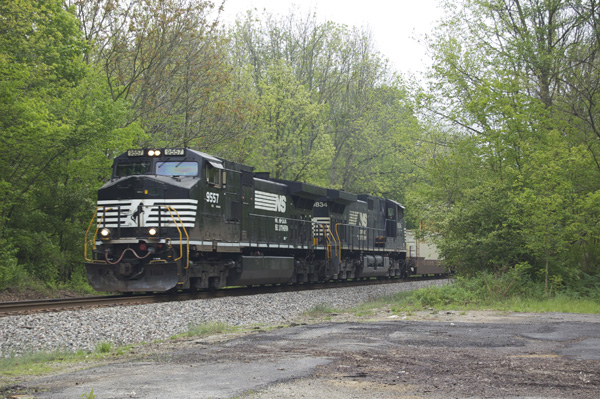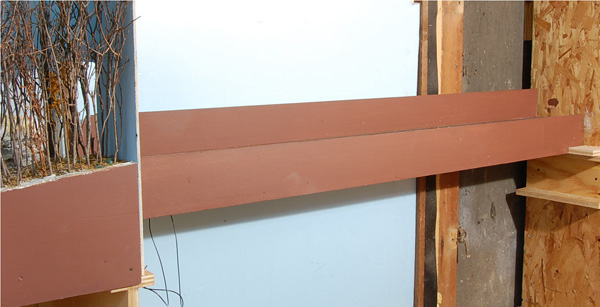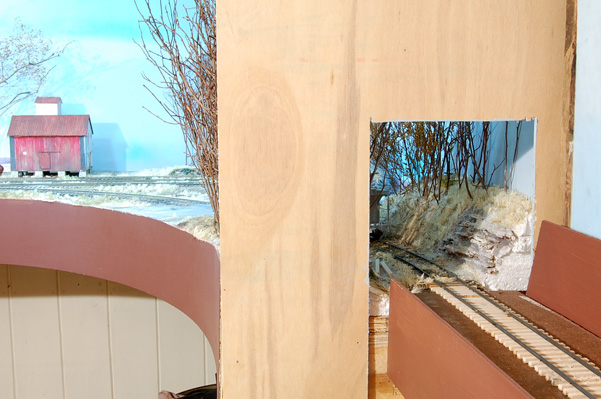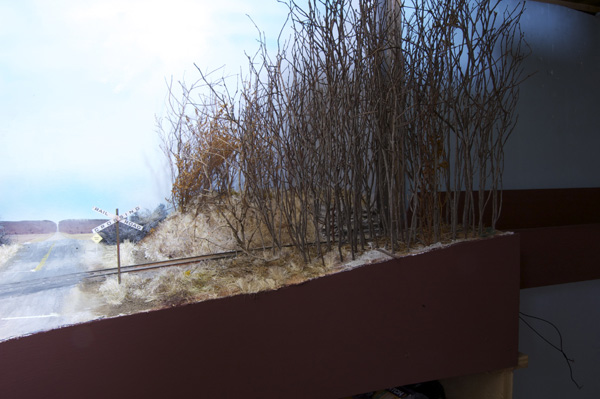No, I’m not referring to stepping down as editor of O Scale Trains Magazine. That’s old news by now. I’m referring to the exit strategies we use to transition from the on-scene portions of a layout to staging.
The use of staging trackage in some form is now well known and accepted for the illusion it provides of the “rest of the world.” We’re all familiar with the various forms it takes, from multi-track yards, to sector plates, portable cassettes, even train length turntables. All of these can be out of sight or increasingly, the sentiment is to keep them in the open but screened from view.
When staging yards were first popularized, convention said to hide them away. After all, when a train leaves the scene in the real world, we can’t just drive down the road a bit and find it sitting there, waiting for the dispatcher to “re-stage it” for tomorrow. Hiding the staging supposedly enhances the illusion that the train indeed journeys onward to wherever.
However, we all know the trick now. It doesn’t really go anywhere but a few feet and then; stop! Plus, the shortcomings of completely hidden yards made themselves known quickly. Mainly a lack of easy access to the equipment. So now, staging that is easily accessible is the favored way, whether it is in a separate room or in the open. In either case, the transition points onto the scenicked portions of the layout still deserve thought and care in how they are treated.
The usual cliche’ is a bridge, building or tunnel to disguise the transition point. These all work effectively when the setting is appropriate for their use. They are cliches’ because they are over used. There are other ways to handle this transition, and a couple of non obvious points to keep in mind. Photo please.
If the transition is a rural scene and you’re modeling the Midwest like I do, consider a cluster of trees. This northbound Norfolk Southern freight train could be making his entrance from a staging yard just beyond the trees on the right in the photo. (Actually, he came up from Cincinnati.) On my Indiana & Whitewater I used a shallow cut with a dense grove of tall trees to screen the exit from the layout to the staging cassette. I also used this technique at both ends where the layout meets the wall of the room to disguise the dead-end nature of this miniature 3D world. I know, using the same technique three times on a small layout like mine borders on boring repetition. I concede that one of those situations could have been handled differently for a change of pace. However, the use of trees for screens was appropriate in all three situations given the prototype I model. It is common and quite ordinary to see the tracks appear and disappear among clusters of tall trees in this part of the country. We don’t give the ordinary it’s due, but that’s another post.
One non-obvious tip is to make the actual point of entry or exit fairly nondescript in terms of detail. Detail draws the eye and this isn’t what you want. Placing a detailed object like a signature tree or a highly textured patch of ground a foot or so away (depending on your modeling scale and the space available) will help draw the eyes away from the point of entry. Another thing to keep in mind with trees is make them tall, perhaps scale height. Look at the height of the trees in the photo. They are several times the height of the train. Afraid scale height trees will take up too much space? Look at the photo again. This scene would easily fit on a narrow shelf a foot wide or less in HO or sixteen inches wide in quarter-inch scale. Bear in mind that consistency is important. If the rest of the nearby trees on the layout are of the typical stunted “dwarf” variety, the use of scale trees in just one isolated spot won’t look right. Be consistent.
Let’s say you want the staging areas right out in the open. Can do.
A friend of mine participates in a Free-mo layout group. Free-mo layouts are free form, self contained, modular layouts built by one or a small group of modelers. Even though these layouts are modular, they are not necessarily designed to be grouped together with other independent modules where all are built to a rigid standard like the N-trak movement.
My friend’s Free-mo group layout features a five track, sector plate style staging yard on one end that is completely visible. They handled the transition from the staging to the layout by including a stretch of plain scenery that included a river crossing with a swing bridge. This section, consisting of nothing more than a single track and simple scenery provides the visual buffer that distracts the eye away from the non-descript staging area (your eye is drawn to the swing bridge). My friend reports this really does work effectively. The staging is visible and accessible but “over there,” essentially out of sight and out of mind. People unfamiliar with the idea can readily see how it works and contributes to the operations, and how the scenic details and operation on the rest of the layout captures and maintains the interest of viewers and operators alike. To see what I’m talking about check out “The Peterboro Project” article in the August 2008 issue of Railroad Model Craftsman.
Another thing to consider is how to handle the requisite hole in the backdrop for the track to pass through, which more often than not, is what we’re really trying to hide. Of course, the tunnel/ building/ bridge treatments handle this automatically by hiding it from view. Where the track goes to the staging cassette on the I&W, I’ve handled it both ways.
I once had a piece of quarter-inch plywood attached to the end of the benchwork with a square hole for the track. Facing the layout, this was painted with sky color to match the backdrop (first photo above). The dense cluster of trees helped hide the obvious hole in the sky. Recently I took this piece down to do some work, and never put it back in place. Funny thing is that with the lower level of light on this section of benchwork, the impact of the sky and scenery just ending abruptly isn’t that noticeable (third photo above). At least to my eyes it isn’t. The bright light in the first two photos is for photography purposes only and is not normal. We also tend to get used to how things look and stop seeing them as others would. As you can see, it can work effectively both ways. The key is controlling where the eyes focus by manipulating light levels and the degree of detail. In this case, less light and minimal detailing is working out fine.
In sum, there are numerous ways to handle the transitions in and out of a scene. Has anyone used a cut of permanently parked, non-descript train cars to screen the exit hole? What about a large advertising billboard? Both of these strategies would work well on a layout that is close to eye level. I’ve only scratched the surface in this post. What are your ideas?
Regards,
Mike



Mike,
I like the staging cassette minus the 1/4″ piece of plywood. Your cassette is barely noticeable. If anything, it looks like the end of a girder bridge in the shadows.
You raise a good point about viewable staging. Most home layouts can do just fine with an open staging area. Your example of the Petersboro project is an excellent example of how the sector plate, while out in full view, is easily overlooked. The only time staging could be hidden is from the viewer of an exhibition layout, but not to the operator.
Matt
Hi Matt,
I agree. Open staging doesn’t have to be a visual roadblock to enjoying a layout. The concept of staging is so common now, everyone knows where the trains are actually going. This doesn’t take away from the usefulness of it at all.
You’re also right, for an exhibition type layout at a show, having the staging area screened or out of sight can enhance the experience of trains coming from and going to other points on the line for the visiting public. There aren’t any hard and fast rules anymore. I think that’s a good thing in general.
Mike